Lecture notes for Introduction to Representation Theory
Lecture notes for Introduction to Representation Theory
Lecture notes for Introduction to Representation Theory
Create successful ePaper yourself
Turn your PDF publications into a flip-book with our unique Google optimized e-Paper software.
⇒<br />
⇒<br />
Now pick V N such that ν V (g) ⇒= 0; it exists by Lemma 4.24. Theorem 4.21 implies that g<br />
(and hence any element of C) acts by a scalar in V . Now let H be the subgroup of G generated<br />
by elements ab −1 , a, b C. It is normal and acts trivially in V , so H = G, as V is nontrivial. Also<br />
H = ⇒ 1, since | C | > 1.<br />
Proof of Burnside’s theorem.<br />
Assume Burnside’s theorem is false. Then there exists a nonsolvable group G of order p a q b . Let<br />
G be the smallest such group. Then G is simple, and by Theorem 4.23, it cannot have a conjugacy<br />
class of order p k or q k , k ⊂ 1. So the order of any conjugacy class in G is either 1 or is divisible<br />
by pq. Adding the orders of conjugacy classes and equating the sum <strong>to</strong> paq b , we see that there has<br />
<strong>to</strong> be more than one conjugacy class consisting just of one element. So G has a nontrivial center,<br />
which gives a contradiction.<br />
4.6 <strong>Representation</strong>s of products<br />
Theorem 4.25. Let G, H be finite groups, {V i } be the irreducible representations of G over a<br />
field k (of any characteristic), and {W j } be the irreducible representations of H over k. Then the<br />
irreducible representations of G × H over k are {V i W j }.<br />
Proof. This follows from Theorem 2.26.<br />
4.7 Virtual representations<br />
Definition 4.26. A virtual representation of a finite group G is an integer linear combination of<br />
irreducible representations of G, V = ⎨ n i V i , n i Z (i.e., n i are not assumed <strong>to</strong> be nonnegative).<br />
The character of V is ν V := ⎨ n i ν Vi .<br />
The following lemma is often very useful (and will be used several times below).<br />
Lemma 4.27. Let V be a virtual representation with character ν V . If (ν V , ν V ) = 1 and ν V (1) > 0<br />
then ν V is a character of an irreducible representation of G.<br />
Proof. Let V 1 , V 2 , . . . , V m be the irreducible representations of G, and V = ⎨ n i V i . Then by<br />
orthonormality of characters, (ν<br />
2 2<br />
V , ν V ) = ⎨ i . So ⎨ i n<br />
i n i = 1, meaning that n i = ±1 <strong>for</strong> exactly<br />
one i, and n j = 0 <strong>for</strong> j = i. But ν V (1) > 0, so n i = +1 and we are done.<br />
4.8 Induced <strong>Representation</strong>s<br />
Given a representation V of a group G and a subgroup H → G, there is a natural way <strong>to</strong> construct<br />
a representation of H. The restricted representation of V <strong>to</strong> H, ResG H V is the representation given<br />
by the vec<strong>to</strong>r space V and the action δ Res G V = δ V | H .<br />
H<br />
There is also a natural, but more complicated way <strong>to</strong> construct a representation of a group G<br />
given a representation V of its subgroup H.<br />
Definition 4.28. If G is a group, H → G, and V is a representation of H, then the induced<br />
representation Ind G H<br />
V is the representation of G with<br />
Ind G f(hx) = δ V (h)f(x)⊕x G, h H}<br />
H V = {f : G ⊃ V | 54

















